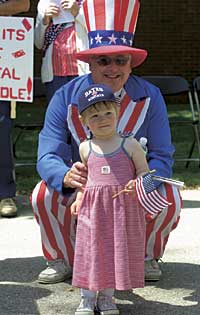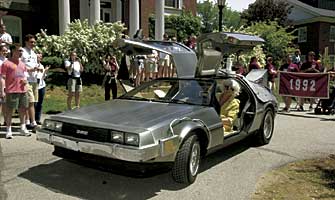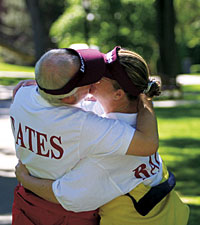Reunion 2002 — Bates to the Future
Happily goofy or thoughtfully retrospective, alumni reorient themselves to Bates.
By H. Jay Burns
Sound waves imbued with the happy mix of shouts, greetings, and laughter bounced through the crisp still Maine air. Encouraged by the slight incline north of campus, the waves stayed intact all the way to Bearce Avenue, about a mile away.
There, around 2 a.m., Dean of Students Celeste Branham briefly awoke. She heard the faint sounds and evaluated their timbre, pitch, and intensity. Like some sort of veteran Maine Guide to the Bates social ecosystem, and despite still being in the grog of sleep, Branham made three deductions quicker than Radar O’Reilly ever said, “Choppers!”:
It’s Reunion.
That’s Page Hall.
Must be the Class of 1997.
Bates physicist John Smedley, even though he’s a Colby alumnus, will explain that Branham’s being able to hear 142 alumni partying outside their Page Hall headquarters is more a function of physics than any proof that the gang of ’97 remains as party-hearty as they were five years ago. (The Rev. Peter Gomes ’65 likes to tease graduating seniors at Harvard by dooming them to a slow decline in which they will return from “the oblivion of alumnihood fatter and balder at five-year intervals.”)
Sound waves simply travel better on nights like the beautiful first night of Reunion, June 7, when radiational cooling leaves higher ground, like Branham’s neighborhood, warmer than the lowlands. As the sounds of the ’97 revelers traveled from Page up to the warmer air of Bearce Avenue, the waves were bent back to the earth, thereby staying within earshot of the dean.
Whatever.

Paul Steinberg ’57 and granddaughter Katherine (2), daughter of Scott Steinberg ’86 and Sarah McKnight Steinberg ’96.
The point (it must be here somewhere) is that Branham, following the relief of realizing that ebullient Batesies in June are more the responsibility of the Alumni Office than her own, only needed a moment to orient herself to the sounds of Reunion 2002.
For anyone who’s witnessed a few Reunions, observing how returning alumni reorient themselves to Bates provides much of the thrill of Reunion. It can happen anywhere: perhaps for Joel Feingold ’77, it came when his approach at 18 during the Reunion golf tournament settled six feet from the pin (alas, the birdie putt missed, but par gave Feingold the tournament win).
In fact, Reunion could serve as a crash course in the social history of the College as alumni reconnect with Bates through the age-old therapy of simple storytelling, both of life at and after Bates.
During the day on Friday, members of the Class of 1952 gave presentations about their lives and careers — fine storytelling, really, dealing with experiences as diverse as Howard Cotton’s volunteer dentistry practice in the dirt-poor Appalachians and Larch Foxon Miller’s years costuming the New York City Ballet. But as striking as their experiences were, for these folks who came of age in an era of seismic social and historical change, their mutual regard and supportiveness were still more moving. Every talk drew a large and avid group of classmates. The applause and laughter came generously, and there was a spirit of familiarity, camaraderie that said simply, “family.”
A presentation Saturday featured three members of the Class of ’77: Dr. Dervilla McCann, Marsha Underwood Haines and Peter Brann, along with Dean of the College Jim Carignan. While “The History of Bates Baseball” drew a crowd across the hall in Pettengill Hall’s Keck Classroom, presenters outnumbered audience for “You Can Go Home Again — Alumni Living and Working in Lewiston-Auburn.” McCann’s story of her introduction to Bates, visiting with a friend, was utterly charming — “I was at a football game. It was raining. I didn’t know what I was doing here.”
But the discussion transcended personal history as the four presenters explored a period of seismic change right here at Bates: the College’s isolation from Lewiston during their time, and the efforts, especially during the Harward administration, to make Bates a part of Lewiston as well as a place within it. Carignan won some laughs with his imitation of President Hedley Reynolds, who brought him to Bates, but less funny was the point of the tale: that it took two years of prodding to get the barbed wire off the fence that separated college and community (to say nothing of getting rid of the fence itself).
Carignan also acknowledged — and it’s too bad few heard it at Reunion — that students of the early and mid-1970s chafed under social rules formulated decades earlier. He and Dean of Students Judith Isaacson ’65 may have chopped the student rulebook by three-quarters in one year, Carignan said, “but habits and routines change a lot more slowly.”
Meanwhile, back out on the Quad, the Class of 1992 played up their return from the “oblivion of alumnihood” with a witty series of then vs. now comments on the back of their class T-shirt (see sidebar). To go along with their “Back to the Future” theme, Al Bruno ’92 volunteered to find a DeLorean like the one in the movie. (To paraphrase Doc Brown’s line, if you’re gonna create a Reunion time machine, why not do it with some style.)
Classmates said right, good luck, and Bruno was off into the Internet wilderness. Only about 6,000 of the ill-fated 1980s sports cars still exist. “I figured I’d have to find one in New Jersey,” he said. But a check with the DeLorean Owners Association revealed an owner barely 10 miles away from campus in rural Otisfield, where Ford F-150 trucks outnumber the deer and a place that’s locally famous for the fact that it has no town center.
“One in a million,” said Bruno.

The DeLorean
It gets better. The DeLorean’s amenable owner, Tom Watkins, once worked in California in the Universal Studios back lot. “The original car they used in the movie is there, and I saw it every day and took a lot of pictures,” said Watkins.
He sold his California DeLorean when he brought his family back to Maine, but soon found another in South Carolina, bought it, and created “a poor man’s version” of the famous Back to the Future DeLorean. That’s the car that rolled slowly around the Quad during the Alumni Parade.
As Al and his wife, Kristin Downs Bruno ’92, drove to Maine from Connecticut, she tried to temper Al’s growing giddiness. “She told me not to be too disappointed if everyone didn’t think the car was cool as I thought it was.”
They needn’t have worried. Veteran parade watchers who’ve seen goats, World War II jeeps, vintage autos, and sleek Harley Davidson motorcycles appreciated the irony of the car that was a cultural blip passing beneath staid Hathorn Hall.
You’d expect fatter and balder thirtysomethings to smile at the car from everyone’s favorite Michael J. Fox movie. But, somewhat surprising, it was the 10-year-old kids who blew their gaskets as Watkins guided the car and Huey Lewis blasted from the boombox inside.
“WHERE DID YOU GET THIS CAR!” screamed one boy, arms stretched wide, as Watkins, even dressed as Doc with a white wig and orange trench coat, emerged from the vehicle. (Funny: You can show a 10-year-old kid your cherished Doobie Brothers albums, and he’ll flash the “what’s up with this guy” look kids learn about the third day of kindergarten. But drive a DeLorean from a 1985 movie on the Quad, and it’s like the Crocodile Hunter stopped by.)
“Kids know the movie,” says Bruno. “It’s one of those movies that parents have figured out is safe for kids.”
Watkins figured that out the first time he parked his DeLorean, minus the movie props, in a parking lot. Walking away, he heard a little boy tell his father, “Aw, Dad, it doesn’t even have a flux capacitor.”
Additional reporting by Doug Hubley.
Reunion Rhetoric
My own personal experience of Don as a teacher in 1990 is a small sample of what everyone from Trustees to first-years has experienced. In a Short Term class of about 30, he met with each of us once a week to discuss paper topics. Once when I walked in, he had copied an article for me on a cogent topic. I think now that he did more work on that paper than I did, but it was a harbinger of what was to come in terms of a person working harder and longer for Bates than, for most of us, is humanly possible. With happiness for you both, we quote Thoreau: You have “other lives to live.” — Michael Bosse ’93, president of the Alumni Association
We have come to love this place you call your alma mater. Thank you for sharing it with us for 13 years. Nothing in our professional lives has meant as much as having the opportunity to be with you. — Don and Ann Harward

Professor Myhrman took our class to a prison, a home for the aging, a home for the mentally infirm. The people were all horribly warehoused. I came back to campus, and in Roger Williams I had a conversion. I decided to be a prophet. Well, I have failed. But I am glad that social justice is now on the front burner of the church in this country. And I am enthused by hearing Bates graduates who are teachers in this community say how much it means to them to have students working with them. You have gotten out of the box into the world in a meaningful way. Ann and I have a poster on our wall, and the quote from the turn-of-the-century educator John Dewey is engraved in my memory: “When saints engage in introspection, burly sinners rule the world.” We cannot let that happen. — Arthur Higgins ’43, recipient, Benjamin Elijah Mays Award
The Benjamin Elijah Mays Award
Arthur Higgins ’43
As a lifelong minister of the Congregational Church in Connecticut, Arthur Higgins has, by the power of moral example and thousands of hours of careful, thoughtful work on behalf of people in need, helped to change the way churches work in America. He has been a pioneer in establishing two new kinds of ministry and church work, both of which have been broadly emulated in other churches throughout America. First, Art was the founder and president of — and remains actively involved in — the New Samaritan Corporation, a wing of the Congregational Church that has been a national model for the involvement of the church in low-income and elderly housing. Arthur was also the first Connecticut Conference Minister of the Department of Church and Society — also a nationally emulated invention — having church organizations at the state and national level involved in broad issues of social justice and fairness.
Finally, in a quiet way, Arthur helped to change Bates. Back when Charles Dana was a member of Art’s church in Wilton, Conn., Art was instrumental in redirecting Dana’s philanthropy to colleges in the Northeast, including Bates. From that came Dana Chemistry Hall, the Dana Professorships, and the Dana Scholarship program at Bates.
College Key Distinguished Service Award
Gene Taylor ’56
When Gene Taylor worked at Bates, he was at his very best when he was at his worst.
Taylor, who won the 2002 Distinguished Service Award from the College Key, served as the College’s planned-giving officer during the 1990s, in addition to many years service as a Bates volunteer.
He was the Development Office contact for alumni and friends who wanted to help Bates through some sort of financial planning, such as a bequest or trust. As an ambassador of contemporary Bates, Gene helped alumni connect today’s Bates with yesterday’s, no small feat given that his constituency’s assumptions about Bates might include memories of legendary treasurer and taskmaster Norm Ross ’22 yelling at students to stay off the grass.
Gene reminded alumni that mid-century qualities like thrift, friendliness, and respect for others still thrive at Bates today. He got to know students, often hosting career internship students who would stay with the Taylors on Peaks Island (the students usually had to rework their internal clocks, since Gene took the pre-dawn ferry from Peaks to Portland, then drove to Lewiston).
Just how much he cares about those Bates qualities came to light once in a while. One year, a student’s flashy red sports car, parked illegally, occasionally blocked the steps from the Lake Andrews parking lot. It was an affront to Bates itself (plus, Gene drove a sensible sedan). On those days that Gene had to squeeze by the car when he arrived at 7, his mood would darken, and he was heard to mutter “Idiot!” as he stalked the halls, and his colleagues got a better idea of one alumnus’ love of Bates.